Survey of the Higher Education Landscape 2023

6 Key Findings on the Higher Education Landscape
It’s no secret that higher education enrollment has faced numerous challenges in recent years. The hurdles seem numerous and daunting, from declining birth rates to rising tuition costs, from student debt concerns to doubts about the value of a college degree.
The economy is constantly shifting, driven by technological advancements and societal changes. Many individuals no longer follow a traditional, linear path through higher education.
So, what’s the way forward for higher education? How must higher education leaders adapt to these transformations and respond accordingly?
The 2023 Survey of the Higher Education Landscape report is your ultimate guide to understanding higher education’s challenges and opportunities in a changing landscape. Explore the six pivotal trends shaping the future workforce and learn how these trends empower education leaders to make learning accessible and empowering for all.
Finding 1: Higher Ed Enrollment Struggles Persist Post-Pandemic
Higher education, as a whole, is still grappling with enrollment challenges at almost every level, and it still needs to catch up to where it was before the pandemic. This trend is likely to keep on going into the foreseeable future.
Spring 2023 showed positive signs of enrollment growth, but the sector still faces the challenge of recovering to pre-pandemic enrollment levels. Community colleges experienced a modest growth rate of 0.5%. On the other hand, undergraduate enrollment remained relatively stable, with only a slight decline of 0.2%. While there may be shifts in where students choose to enroll, the overall number of undergraduate students hasn’t seen a significant drop.
While we work on addressing these enrollment challenges, we can’t ignore their impact on the larger problem of declining trust in higher education.
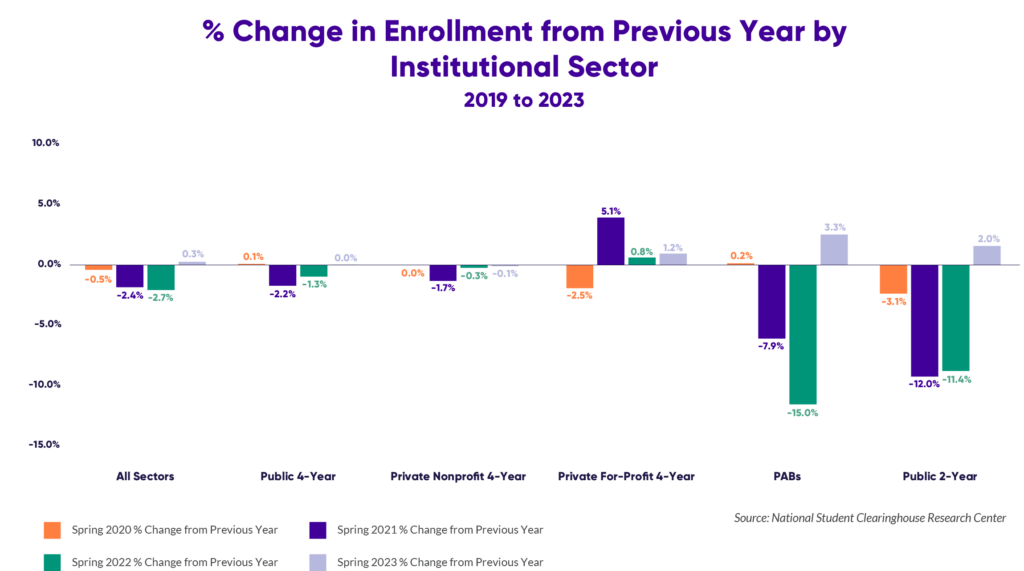
Finding 2: Public Confidence in Higher Education is Rapidly Declining
Once considered a highly trusted institution in American society, higher education, on the whole, is facing a crisis of confidence. In just eight years, the number of people expressing strong confidence in higher education has dropped to 36%. There are myriad reasons for this decline, including the increasing cost of higher education, the online public discussion on towering student debt, and a rapidly evolving economy among the leading factors.
In simpler terms, trust in the value of higher education has taken a hit over the years, and paying attention to this is essential.
Higher education institutions must prepare to communicate why higher education matters to address these concerns. It’s not just about where to get a degree; it’s about understanding the “why” behind pursuing it. That’s why colleges and universities are actively closely monitoring labor market trends and industry demands. By staying in tune with industry trends and the skills employers are looking for, schools can help students see the value in higher education.
It’s worth noting that the changing sentiment about higher education coincides with a generational shift in how students approach their educational journeys.
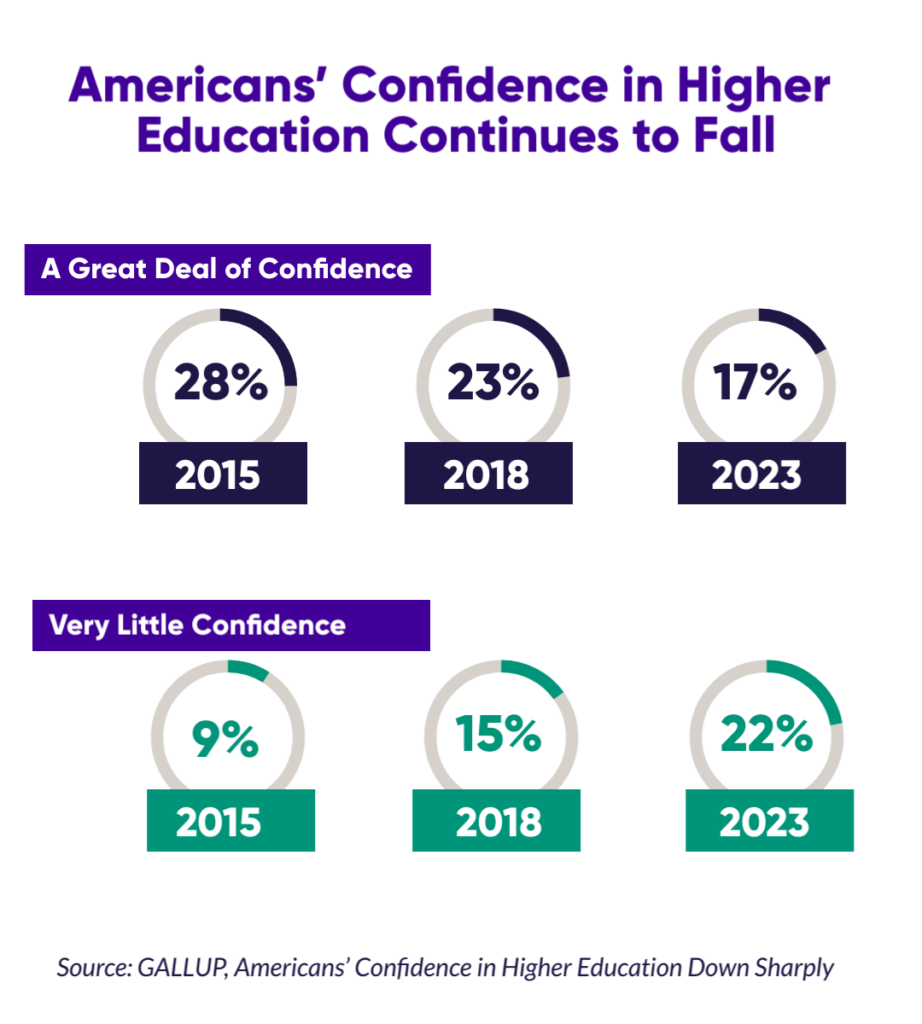
Finding 3: Students Studying Part-Time and Online Continue to Get Younger
Have you ever wondered why younger students increasingly opt for online and part-time education? It’s not just a pandemic-related phase; it’s a substantial and lasting shift in the educational landscape.
Many students face a complex balancing act as they simultaneously juggle the demands of work, family, and school. It’s no small feat and can be incredibly challenging for younger individuals just starting their educational journey. Online and part-time programs come into play here, offering the flexibility that these students need to navigate their busy lives.
One of the most compelling factors behind this trend is convenience. Studying from the comfort of your own home or fitting classes around your work schedule is a game-changer. You no longer need to commute to a physical campus or adhere to rigid class schedules. This flexibility is a significant draw for younger students, especially those who may be early in their careers or managing family responsibilities.
Economic factors also play a pivotal role in this shift. The cost of a traditional education is rising, a factor that’s hard to ignore. Younger students seek more affordable alternatives to prevent drowning in student debt. Moreover, they know the abundant employment opportunities of possessing the right skills and qualifications. Students are eager to swiftly transition into the workforce and capitalize on the available job opportunities. Online and part-time programs can help them achieve these goals, often more cost-effectively.
The numbers reveal a compelling story of this shift. The average age of part-time undergraduate students has decreased by 3.46% since Spring 2019, with an additional drop of 0.79% in the past year alone. These changes suggest that younger students are now embracing part-time studies. Even post-baccalaureate (PAB) students, who typically hold a bachelor’s degree and pursue further education, are getting younger. The average age of PAB students has decreased by 5.78% since Spring 2019, followed by another 2.95% decrease in the past year.
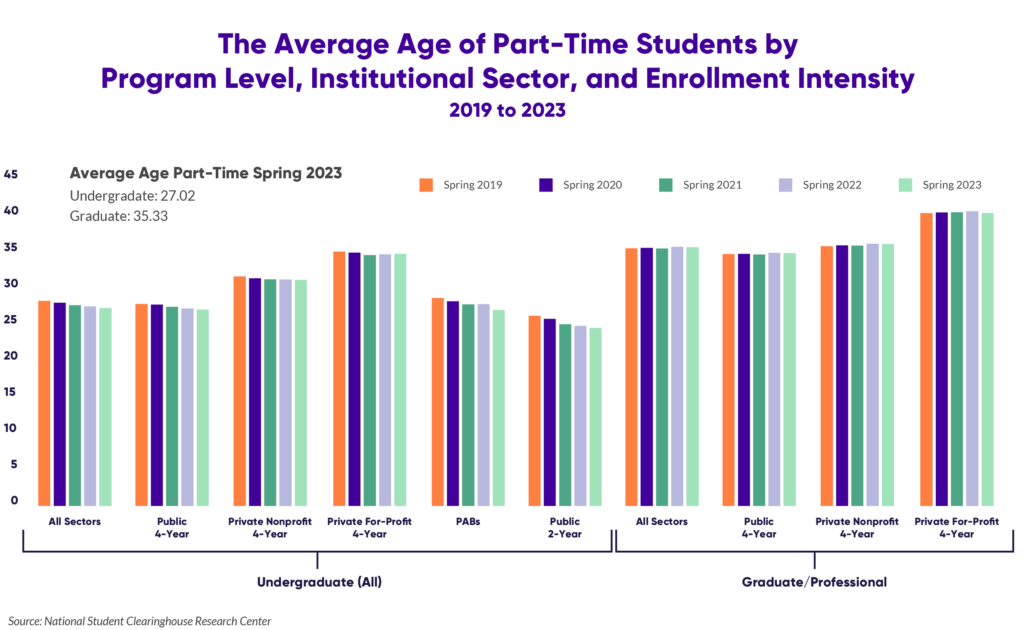
Public 2-year institutions are also in the spotlight. Their average student age dropped by 6.48% since Spring 2019, with a further 1.18% decrease in the past year. These colleges are becoming a magnet for younger learners, who find these institutions particularly appealing.
In a world where balancing multiple responsibilities is the norm, online and part-time education is becoming a beacon of hope for younger students. It’s not just a trend; it’s a shift here to stay, revolutionizing how we think about education and its accessibility.
As we take a closer look at how education and job opportunities are changing, it’s clear that people are making choices that align with their need to earn a living. The increasing popularity of options like online and part-time programs is closely connected to the hurdles individuals encounter when trying to secure employment and is intertwined with the challenges individuals face in the job market.
Finding 4: The Number of Americans Classified as Some College, No Credential (SCNC) Continues to Grow
The number of individuals classified as Some College, No Credential (SCNC) is on the rise. While they’ve invested significantly in their education, they face a significant challenge. Despite their efforts, they work diligently to discover their value in the job market. What’s more concerning is that this group is the only one projected to experience a decline in employment opportunities over the next decade.
Most of these individuals are in the prime years of their careers, with almost 65% being under the age of 35, signifying that a significant portion of the Some College, No Credential (SCNC) population is at a stage in life where they should be building a stable career.
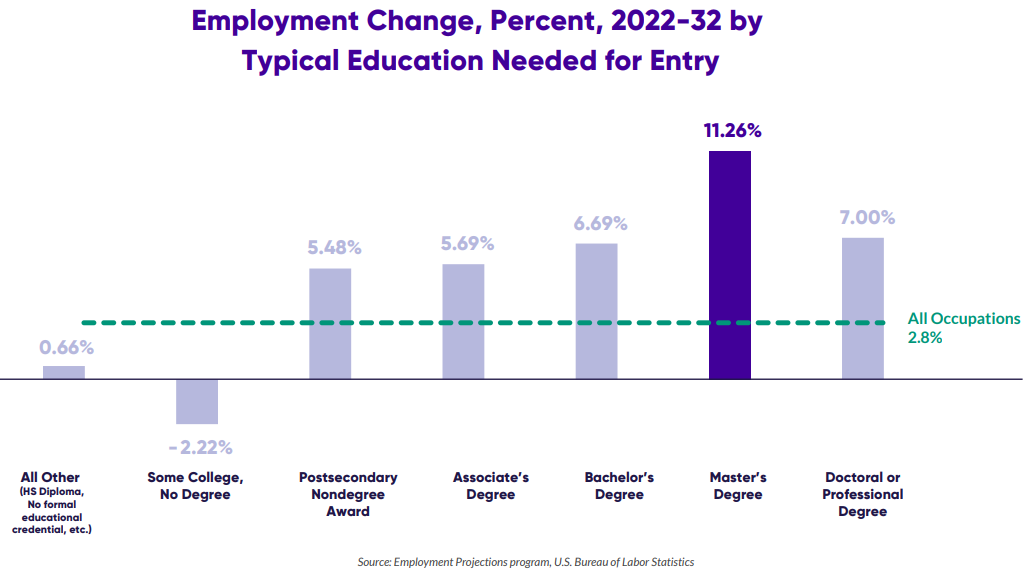
On the flip side, the data suggests remarkable growth in jobs requiring a master’s degree over the next decade, with an estimated increase of 11.26%. In contrast, the Some College, No Credential (SCNC) group will likely see a 2.22% decline during that same time. These figures imply that while jobs demanding a higher level of education are on the rise, individuals with incomplete education face challenges in the job market.
Looking at the age distribution, we see that most “Some College, No Credential (SCNC)” individuals belong to the 20-24 age group, a crucial phase when they should ideally be turning their education into promising career opportunities.
In a nutshell, this data spotlights the need for individuals to complete their education and attain relevant credentials to secure their careers in an evolving job market. It also underscores the increasing demand for master’s degrees to unlock promising job opportunities. It’s a vital discussion for both students and policymakers.
As we dig deeper into how education and work are connected, one thing stands out: completing a degree or credential is not just about personal growth – it’s a significant factor in employability.
Finding 5: College Degrees or Credentials Correlates with Lower Unemployment
The value of a college degree or credential is evident, and opportunities exist for both students and schools. The spike in unemployment is hitting those with less formal education the hardest.
Among those with degrees, individuals with associate degrees saw the most substantial improvement in their unemployment rates in 2023. Indicating that associate degrees are becoming even more valuable in the job market, individuals holding these credentials find it easier to secure employment.
For individuals classified as Some College, No Credential (SCNC), their unemployment rate is nearly double that of those with degrees. This stat implies that completing a degree or microcredential improves your chances of finding and retaining employment. It’s a dynamic situation, highlighting the importance of starting and completing higher education to enhance your employment prospects.
As we explore the impact of education on employment, we can’t ignore the fact that the job market is evolving, with certain fields showing exciting potential.
Finding 6: There are Promising Opportunities on the Horizon for Online Programs in High-Growth Fields
Exciting prospects lie ahead, especially in fields where job growth outpaces the number of degrees completed. These are called “High Opportunity programs,” which hold great potential for students and educational institutions.
These fields present a unique challenge and opportunity. While individuals may temporarily fill the gap with less formal education, those with degrees maintain a competitive edge in the job market.
Let’s take the field of Homeland Security, Law Enforcement, Firefighting, and Related Protective Services as an example. In the last five years, it has seen a remarkable 46% increase in job demand despite a 20% decrease in degree completions.
This trend also holds over a ten-year timeline. While overall enrollments have declined, the need for highly educated employees remains. Organizational Behavior Studies is a prime example, offering prospective students an 89% increase in job demand over a decade despite a 35% decrease in degree completions.
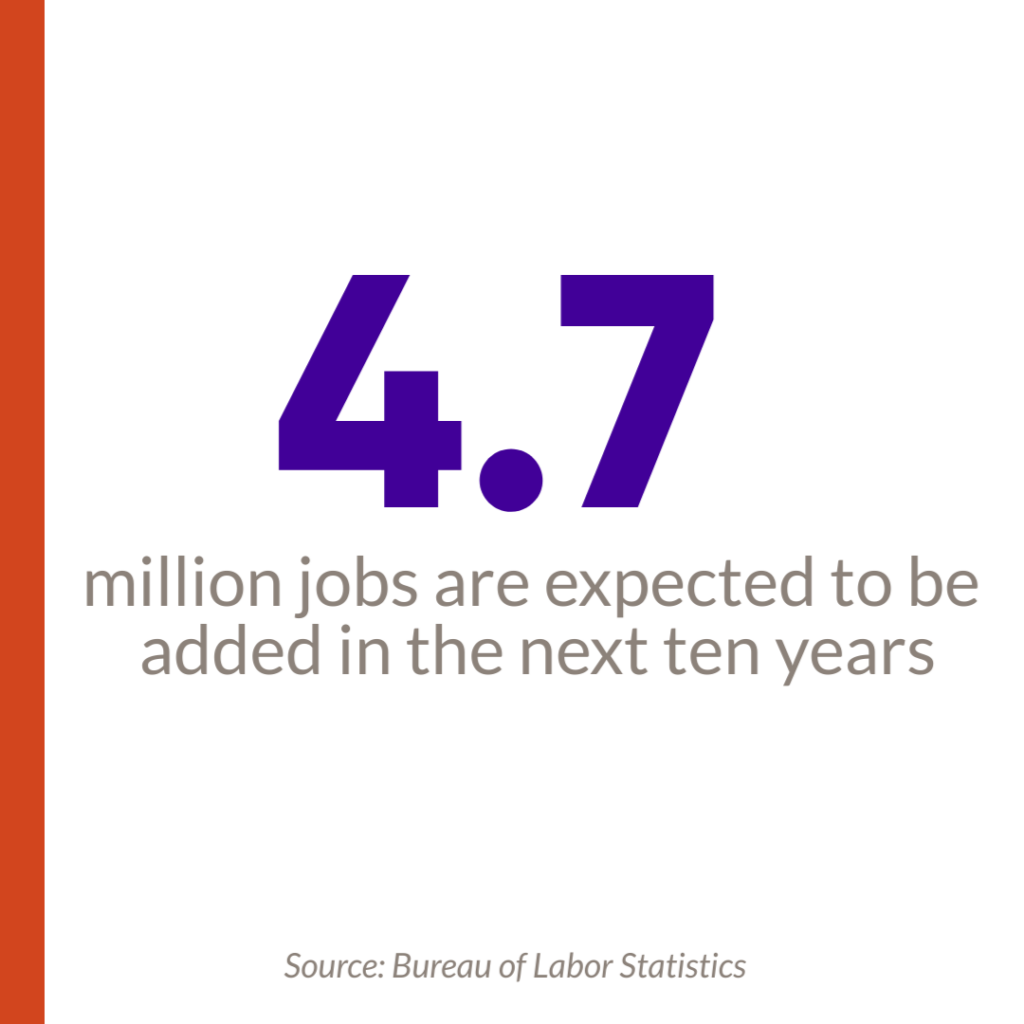
This mix makes high-opportunity programs an appealing pathway for schools. These programs bridge labor market gaps and ensure positive job prospects for students while increasing enrollments.
Navigating the Challenges of Today’s Educational Landscape
There’s no denying the crucial role of higher education in enhancing employability and ensuring economic stability. The path to success has become less straightforward, with many embarking on a college journey but only sometimes reaching the finish line, leaving untapped potential.
The primary focus should be developing programs and pathways tailored to serve Some College, No Credential (SCNC) students, who often balance work, family, and education commitments. By providing flexibility, educational institutions help individuals adapt to changing circumstances, build economic resilience, and navigate economic challenges while maintaining financial stability.
Addressing these evolving needs requires a student-centered full-funnel marketing approach. It’s not just about attracting students; it’s about guiding them throughout their entire journey, from their initial discovery of educational options to the moment they make that final decision. This way, students grasp the broader value of higher education and why returning to school is a compelling choice.
Focusing on outcomes-centered content is vital. It serves a dual purpose: capturing students’ attention and providing them with valuable information to reinforce their commitment each semester.
These programs go beyond education; they create enduring value and opportunities for students and institutions.
Taking a step back and looking at the larger picture, it’s clear that the economy powerfully highlights how important higher education is. Despite fluctuations in public confidence in higher education, individuals consistently seek opportunities to enhance their skills and realign themselves for success.
Are you looking to navigate the challenges of today’s competitive educational landscape and drive positive change in your institution? Unlock comprehensive insights into the higher education landscape through the 2023 Survey of the Higher Education Landscape report. This report guides you to building authentic brands and offering student-centered enrollment experiences.
Harness EducationDynamics’ market research expertise to explore how you can strategically pave the path to enrollment growth in the ever-evolving higher education landscape.
Download the 2023 Survey of the Higher Ed Landscape report and learn more about today’s labor market and student enrollment trends.